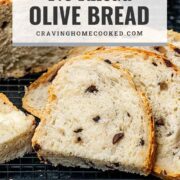This post may contain affiliate links. Please read my disclosure policy.
Bread lovers, gather ’round! Meet crusty and delicious No Knead Olive Bread, where time and patience are the secret ingredients. Crafted with just a few pantry staples, this artisanal masterpiece marries the ease of the no knead technique with briny Kalamata olives!
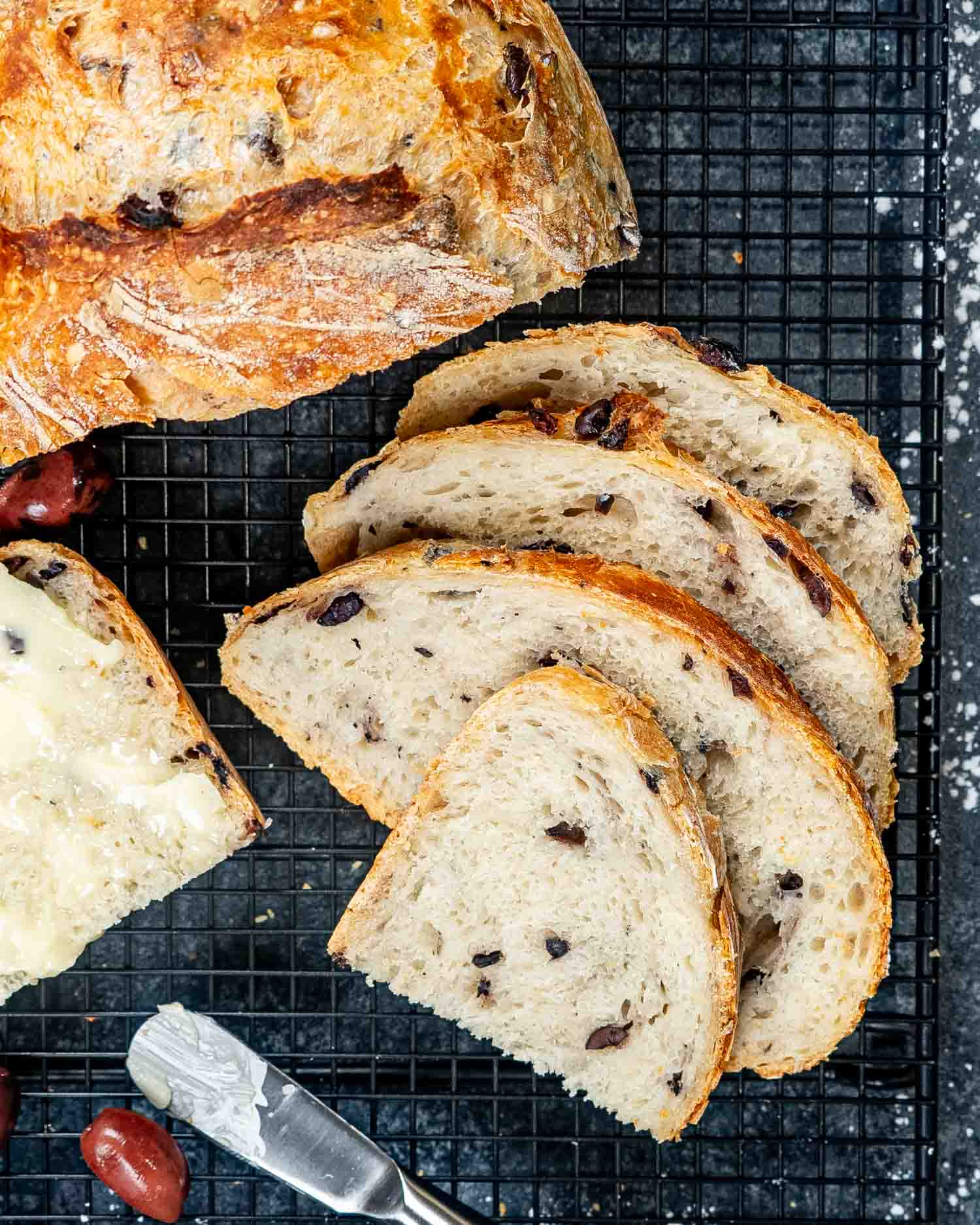
What Is No Knead Olive Bread
Get ready to toss tradition out the window and welcome the no knead bread revolution with open arms! Unlike traditional bread recipes that demand vigorous kneading, this method uses time and fermentation to let the dough naturally develop its gluten structure. The outcome is flawlessly baked bread that is incredibly soft on the inside with a delightfully crispy crust.
But the story gets even tastier with this no knead olive bread recipe, which takes the simplicity of no knead baking to a new level by infusing it with the bold flavors of briny Kalamata olives. With every bite, you’ll savor the seamless blend of convenience and gourmet excellence. It’s a match made in bread heaven, producing a loaf that pairs perfectly with dishes like Mediterranean Chicken and Mushroom Pasta.
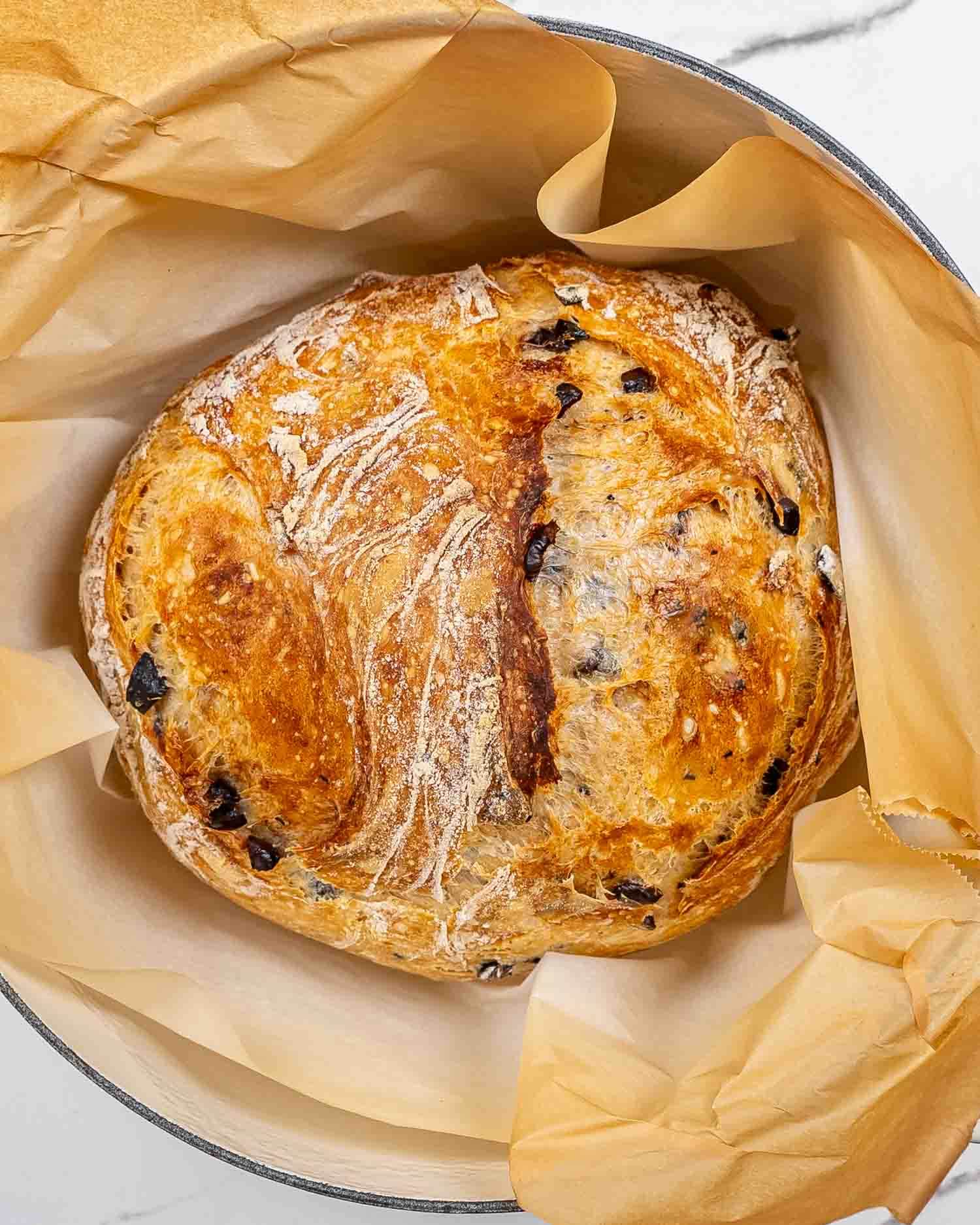
Why You’ll Love No Knead Olive Bread
- Foolproof Homemade Bread! No need to knead! This easy recipe takes the hassle out of traditional bread-making. A combination of time, fermentation, and a cast iron pot work together like magic!
- Crusty Olive Deliciousness! Featuring a golden-brown, crispy crust and a soft interior infused with the briny Mediterranean flavor of Kalamata olives, this no knead bread is a bread lover’s dream come true!
- Versatile Bread! From being a hearty companion to wholesome soups and stews to acting as a canvas for artisanal sandwiches and an elegant charcuterie board, this incredible no knead olive bread will elevate any meal!
Ingredients You’ll Need
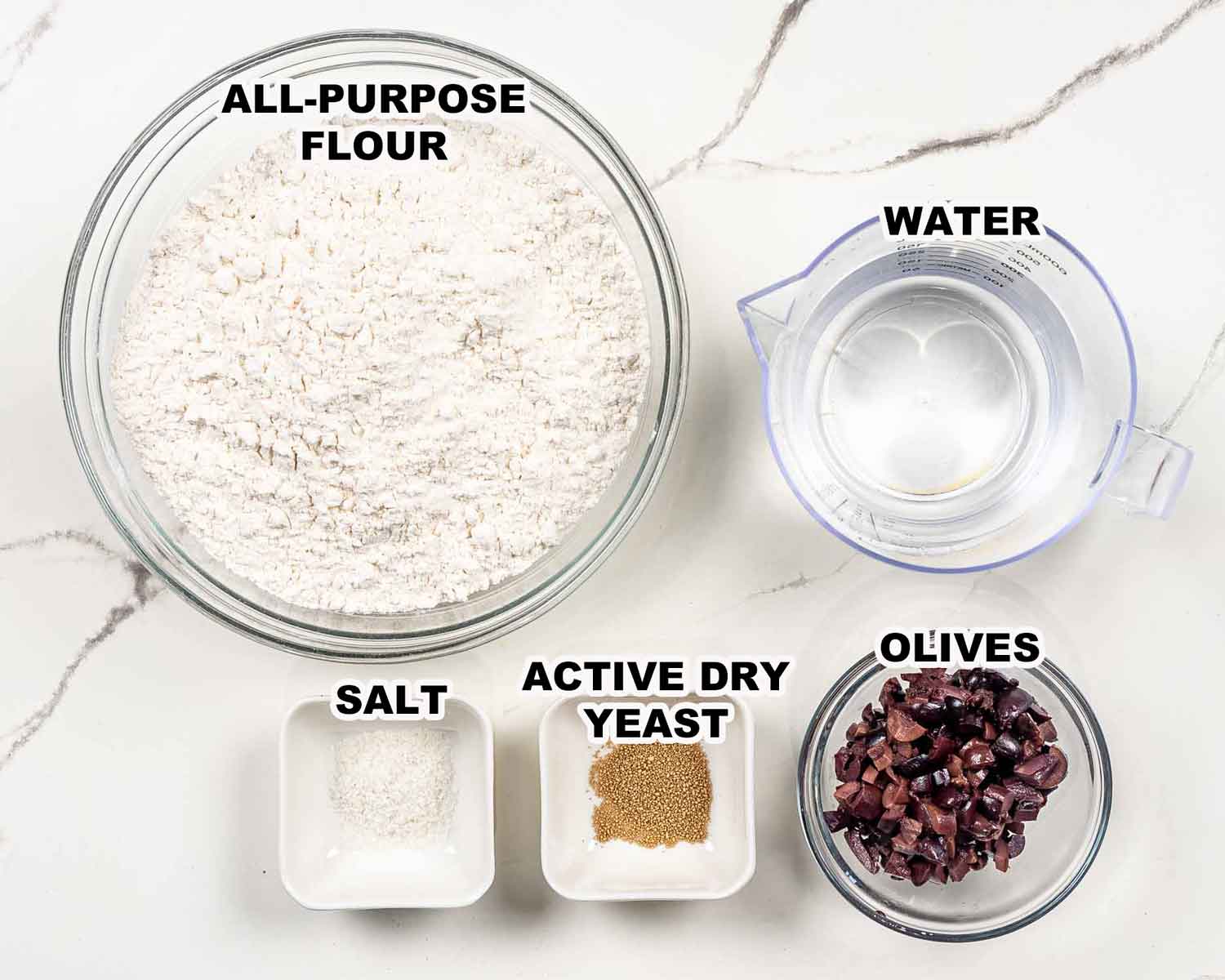
- Flour – Basic all-purpose flour is all you need! However, you can use bread flour if you prefer.
- Active Dry Yeast – The leavening agent used to make the dough rise. Be sure to check the expiration date on your yeast.
- Salt – A touch of salt helps develop the flavor of the dough.
- Kalamata Olives – Infuse the bread with a delightful briny Mediterranean flavor. You can also use green olives and black olives.
- Water – You need lukewarm water that is between 105°F to 115°F (41°C to 46°C) to activate the yeast and bind the dough together.
Whipping up a loaf of this no knead bread recipe is a total breeze and practically foolproof! Yes, it calls for a little patience, but the steps are super easy and the results are incredible!
Make The Dough

Activating the yeast before making the dough is not necessary! Simply combine the flour, yeast, and salt in a large bowl. Next, mix the chopped olives into the flour mixture until evenly distributed.
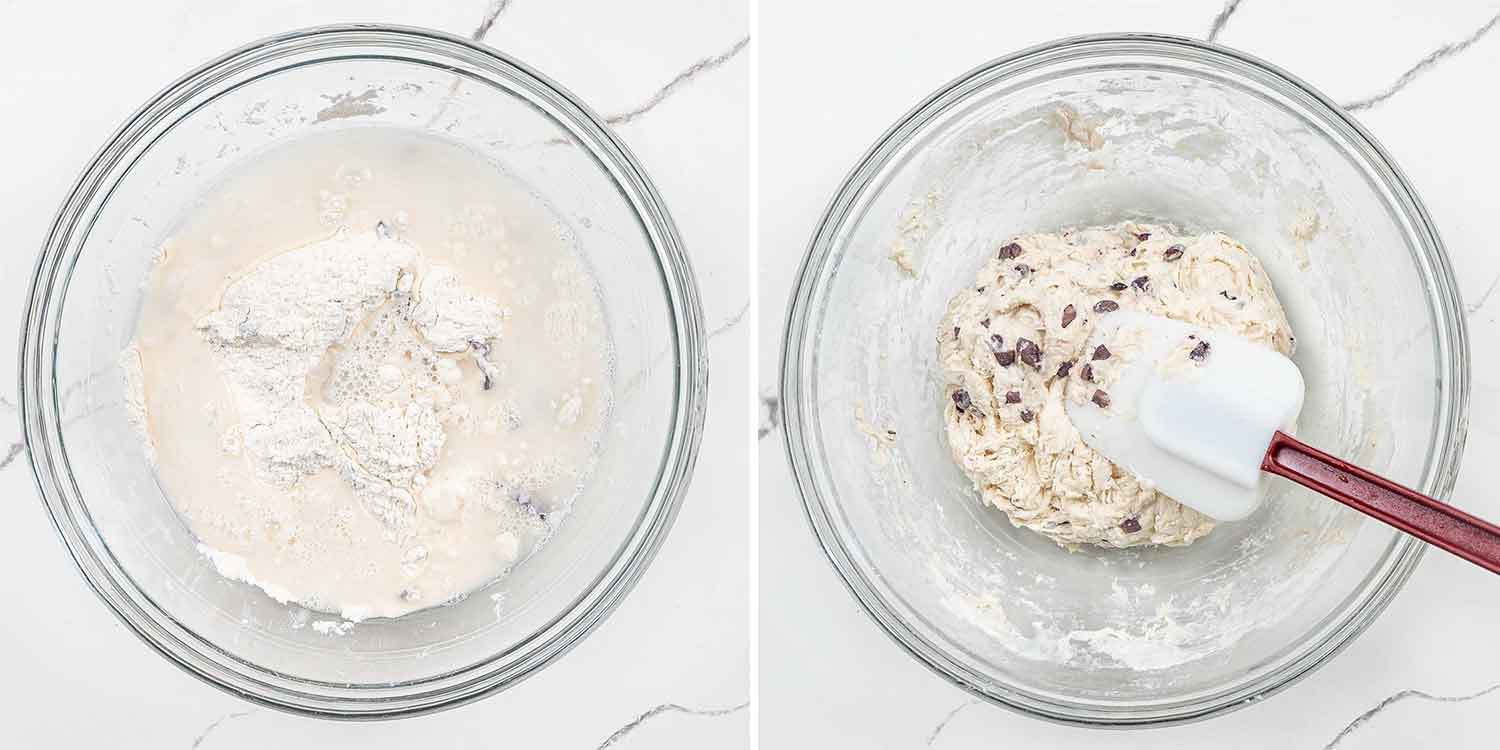
Then pour the warm water over the dry ingredients and mix everything together with a wooden spoon or rubber spatula until a sticky, shaggy dough forms.
Let The Dough Rise
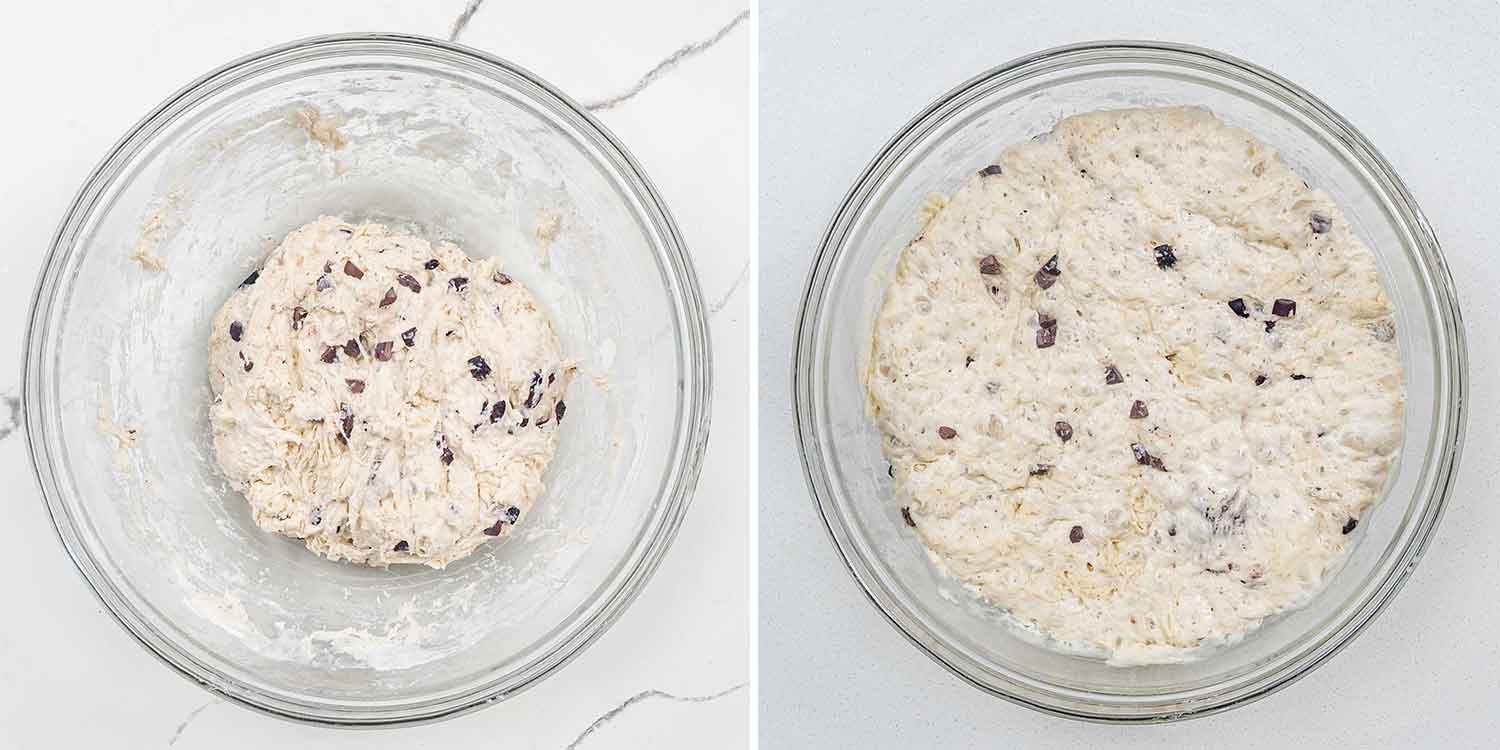
After making the dough, kneading is not necessary, but it does require adequate time to rise. Cover the bowl with plastic wrap and allow the dough to sit at room temperature for 12 to 18 hours. When it’s ready it should be dotted with bubbles and have doubled in size.
Prep For Baking

Once the dough has risen, preheat your oven to 450°F (232°C) and place a cast iron Dutch oven with its lid on inside the oven for 30 minutes as it preheats. Next, sprinkle some flour on a piece of parchment paper and transfer the dough onto the paper. Then use your well-floured hands to shape the dough into a round loaf.
Form The Dough
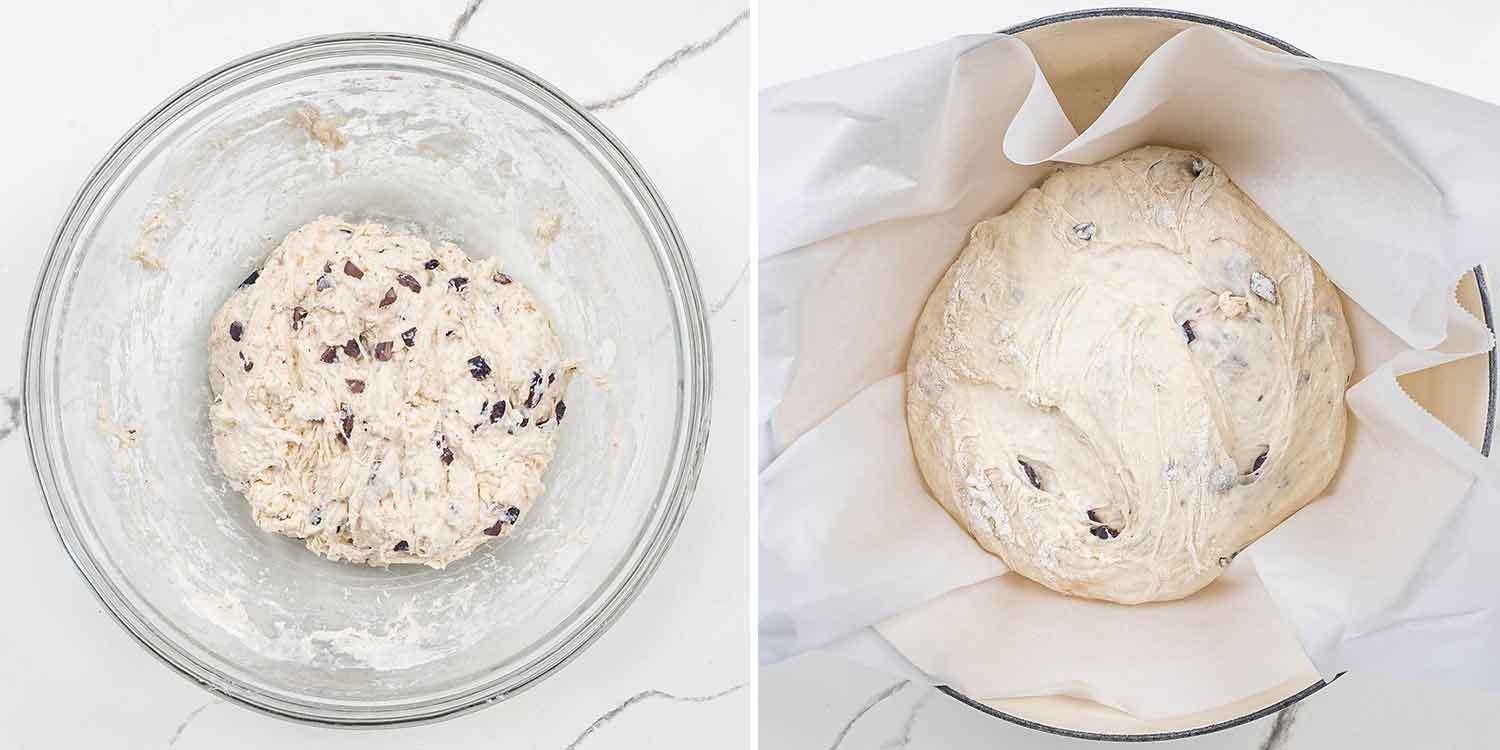
After preheating the Dutch oven, carefully take it out of the oven and put the parchment paper with the dough inside the pot. Then use a sharp knife or a bread lame to make two shallow, diagonal cuts, each measuring ½ inch in depth, on the surface of the bread.
Bake The Bread
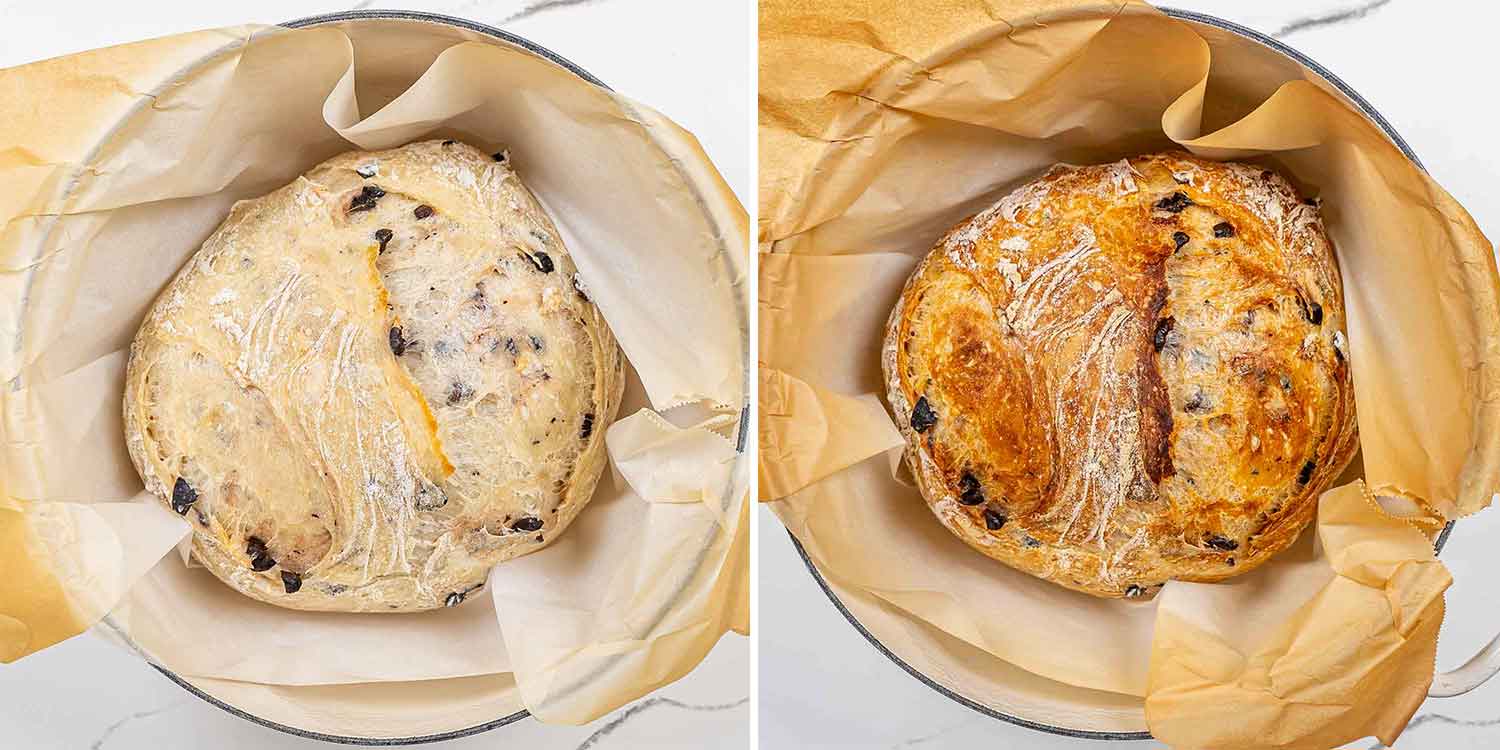
Start by placing the lid on the cast iron pot, and then put the bread in the oven to bake for 30 minutes. Next, take off the lid and continue baking the bread for another 15 to 20 minutes, or until the crust is a golden brown hue and the bread produces a hollow sound when tapped on the bottom. Then remove the no knead olive bread from the Dutch oven and let it cool on a cooling rack for a minimum of 30 minutes before slicing it and serving with olive oil if you like.
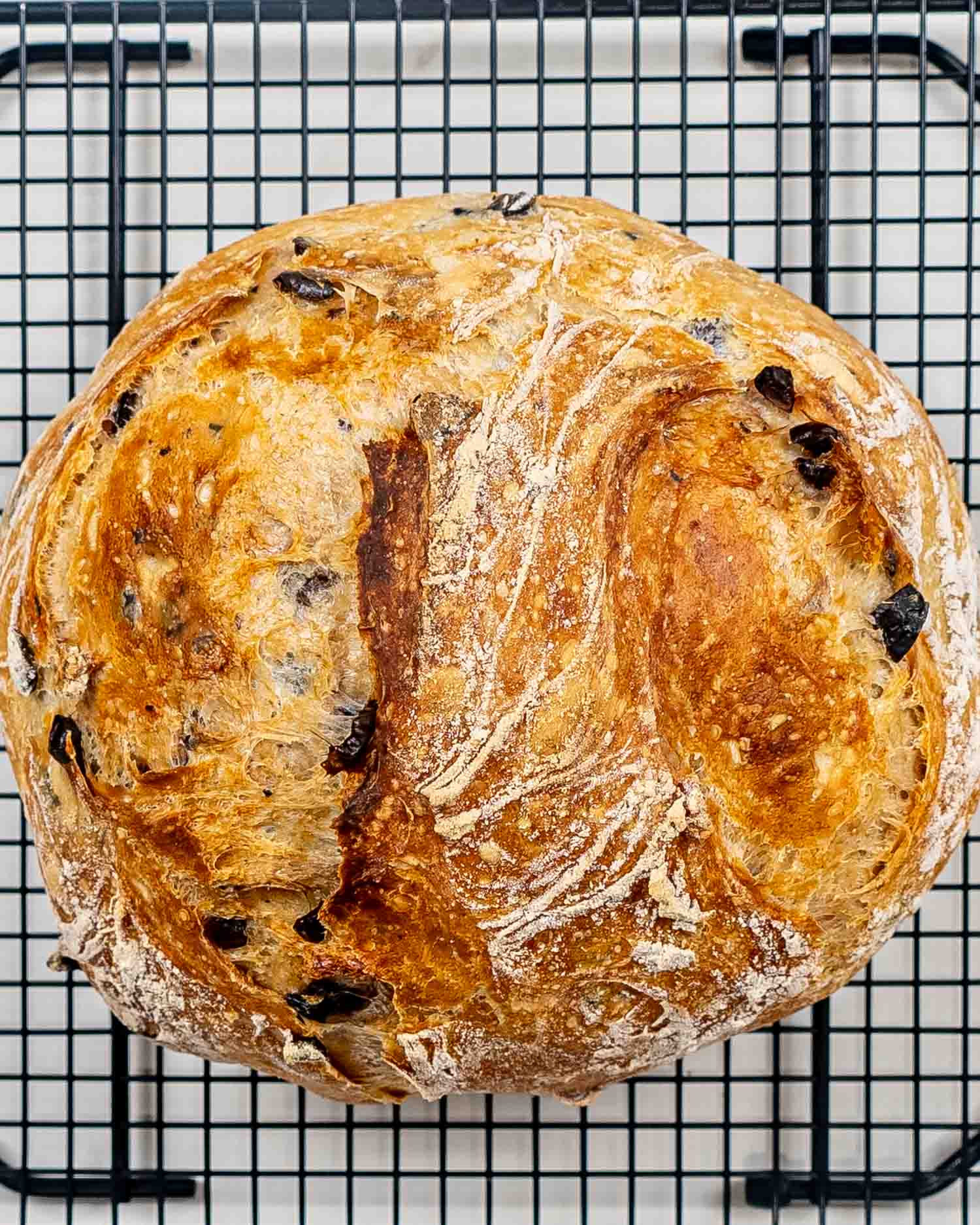
Frequently Asked Questions
What can I add to my bread dough?
You can incorporate ingredients like fresh herbs such as rosemary or thyme, garlic, dried fruits, nuts, seeds, or even different types of cheese like parmesan.
Why is my no-knead bread so dense and heavy?
One common reason is insufficient rising time. Make sure you allow the dough enough time to double in size during the fermentation process. Additionally, accurate measuring of ingredients and proper water temperature are crucial too.
Is it bad to knead no-knead bread?
I don’t recommend kneading no-knead bread dough. The no-knead technique relies on extended fermentation. Therefore, no-knead bread recipes frequently use a wetter dough, which encourages gluten development over a prolonged period instead of kneading. This approach yields a more open crumb structure with larger air pockets and a tender interior.
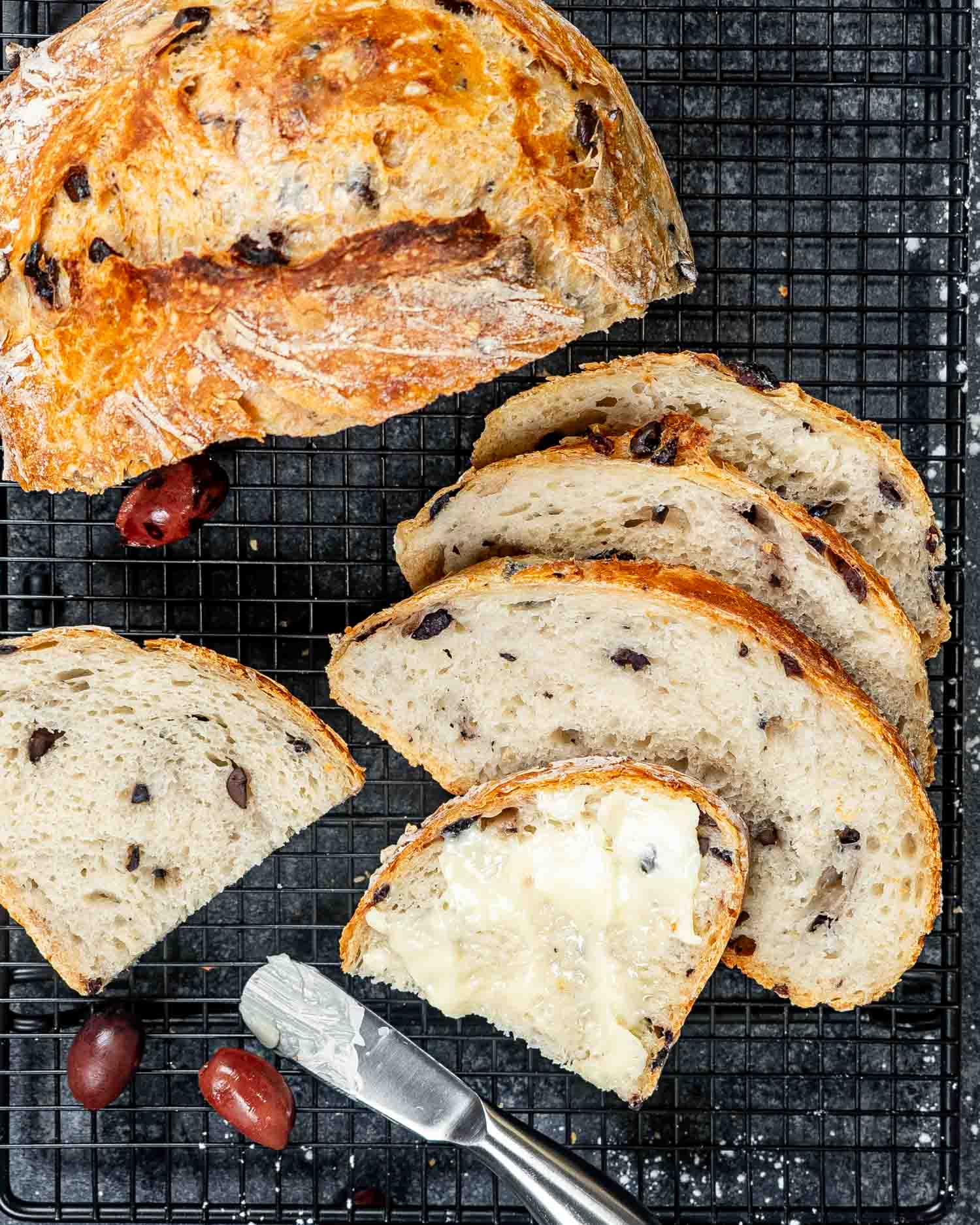
Expert Tips
- Make sure your yeast is fresh. Expired yeast is the main reason that homemade bread fails. Before starting the recipe, double-check the date on the package.
- Lukewarm water is a must. If the water is too hot it will kill the yeast and if it’s too cold it won’t activate it. You want the water temperature to range between 105°F to 115°F (41°C to 46°C) to ensure that the dough rises properly.
- Be patient and let it rest. You don’t have to knead the dough, but because of this, you must let it rest for at least 12 hours. Dough that hasn’t doubled in size will lead to dense bread.
- Do not skip preheating the pot. You must heat the Dutch oven for a full 30 minutes before you add the dough and bake the no knead olive bread. This is what creates a crispy crust.
Storage
You can store no knead olive bread at room temperature for up to 4 days in an airtight container or bag. You can also store it in the freezer for up to 3 months in a sealed freezer bag or double-wrapped in plastic wrap. When you’re ready to enjoy it, simply let the bread thaw out at room temperature for a few hours before serving.

Discover More Delicious Breads

No Knead Olive Bread
Equipment
Ingredients
- 3 cups all-purpose flour
- ½ teaspoon active dry yeast
- 1 teaspoon salt
- ½ cup Kalamata olives pitted and chopped
- 1½ cups warm water
Instructions
- In a large mixing bowl, whisk together the flour, yeast, and salt.
- Add the chopped olives to the mixing bowl and stir them in until evenly distributed.
- Pour the warm water over the dry ingredients and stir everything together with a wooden spoon until a shaggy dough forms.
- Cover the mixing bowl with plastic wrap and let the dough rise at room temperature for 12-18 hours, or until it has doubled in size and is dotted with bubbles.
- Preheat your oven to 450°F and place a cast-iron Dutch oven with a lid in the oven to preheat for 30 minutes. While the Dutch oven is preheating, dust a sheet of parchment paper with flour and transfer the dough onto the floured parchment paper.
- Use your well floured hands to gently shape the dough into a round loaf.
- Once the Dutch oven is preheated, carefully remove it from the oven and place the parchment paper with the dough inside. Use a sharp knife or a bread lame to make two shallow, diagonal cuts that are ½ inch deep on the top of the bread.
- Cover the Dutch oven with the lid and bake the bread for 30 minutes.
- After 30 minutes, remove the lid and bake the bread for an additional 15-20 minutes, or until the crust is golden brown and the bread sounds hollow when tapped on the bottom.
- Remove the bread from the Dutch oven and let it cool on a wire rack for at least 30 minutes before slicing and serving.
Tips & Notes:
- All-Purpose Flour: The foundation of your bread. For a healthier option, you could try whole wheat flour, but it may alter the texture.
- Active Dry Yeast: The leavening agent that helps the dough rise. Instant yeast can be substituted in equal amounts.
- Salt: Enhances the flavor of the bread. You can adjust the amount to suit your taste.
- Kalamata Olives: These add the Mediterranean flair. Green olives can be substituted if you prefer a milder flavor.
- Warm Water: Helps to activate the yeast. Make sure it’s not too hot, or it will kill the yeast. You want the water temperature to range between 105°F to 115°F (41°C to 46°C) to ensure that the dough rises properly.
